Estádio da Luz witnessed history last Tuesday. The Lisbon-based stadium hosted the UEFA Champions League semi-final which brought together RasenBallsport Leipzig and Paris Saint-Germain. This was RB Leipzig’s first-ever taste of the semi-final, while for Paris this was only their second time since 1996.
The match provided a tight tactical battle from both managers. Both teams cancelled each other at times, but Paris eventually got the ticket to the final after a convincing three-goal victory. Interestingly, none of their goals came from open plays. So, how did they unlock RB Leipzig’s defence? This tactical analysis will inform you about that.
Lineups
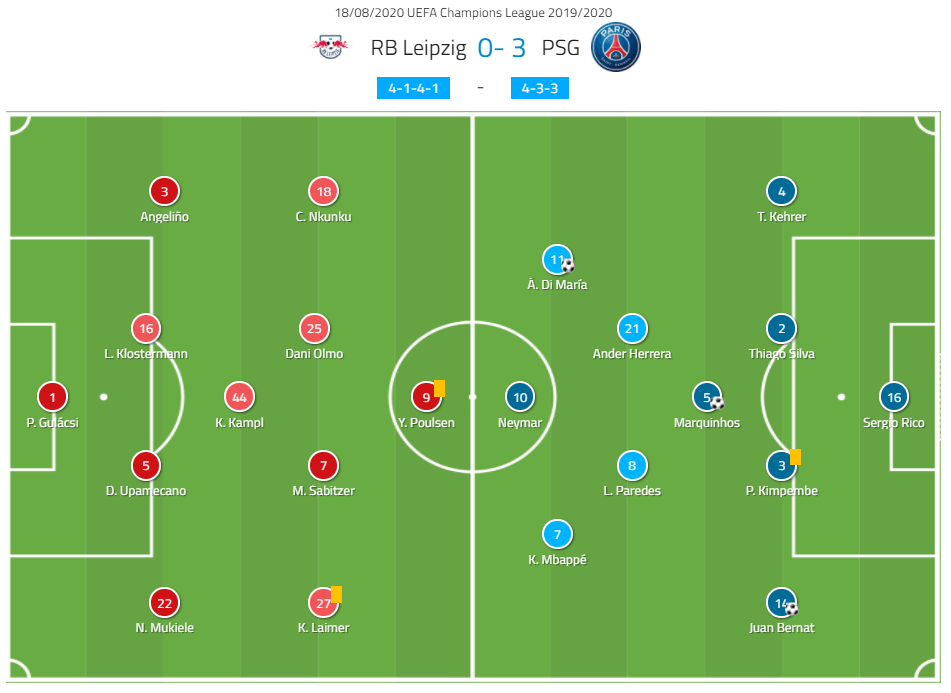
Julian Nagelsmann chose 4–1–4–1 as his go-to formation in this game. However, Leipzig’s structure wasn’t rigid as it varied from time to time depending on the team’s need at that moment, we will dig deeper about that later. In the 4–1–4–1, the duo of Dayot Upamecano and Lukas Klostermann started in front of former Liverpool goalkeeper Péter Gulácsi. Up front, Yussuf Poulsen was supported by the likes of Christopher Nkunku and Konrad Laimer. Finally, Leipzig’s bench was filled with players like Willi Orban, Emil Forsberg, Tyler Adams, Patrik Schick, and Marcel Halstenberg.
In the opposite side, Thomas Tuchel opted for 4–3–3. Sergio Rico replaced the former Real Madrid goalie Keylor Navas in between the sticks, due to the latter’s hamstring injury. In front of him, Thiago Silva and Presnel Kimpembe were chosen as the centre-back pairing. Talisman Neymar led the frontline alongside Kylian Mbappé and Ángel Di María. Names like Marco Verratti, Eric Maxim Choupo-Moting, Pablo Sarabia, and Julian Draxler had to start the game from the bench.
Unique attacking set-up from Les Parisiens
This analysis will start by examining PSG’s attacking tactics. First of all, this was because RB Leipzig chose to cede possession to Les Parisiens in the first half. The stats showed PSG even had 77% possession in the closing 15 minutes of the first period while having a slightly lower 71% as their average from the opening half.
When having the ball, Tuchel instructed his men to play in a lopsided 2–2–5–1-ish structure. In this system, both full-backs — Thilo Kehrer and Juan Bernat — moved forward to provide the width. Then Neymar and Di María would tuck inside and play in the half-spaces. The former even could be found roaming in between the lines at times. Up top, Mbappé stayed forward to pin the backline as well as allowing space in between Leipzig’s lines.
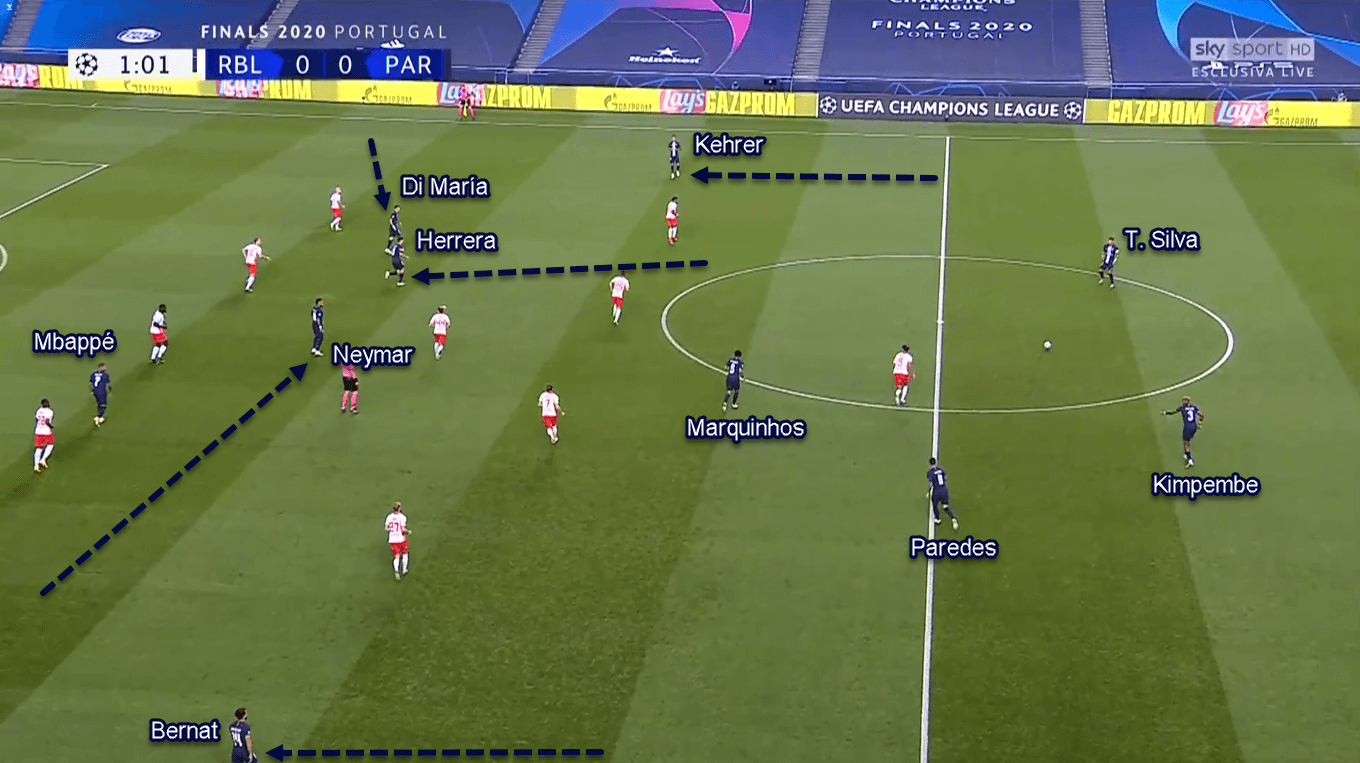
Those were not the most interesting parts, though. It was Paris’ midfield as Tuchel instructed his midfield trio to spread differently. Leandro Paredes and defensive midfielder Marquinhos were tasked to play just in front of the centre-back pairing, while Ander Herrera had to step up to play in between the lines.
The objective behind this was mainly to utilise Paredes’ passing ability. By putting himself deeper than Herrera, Paredes could provide line-breaking passes to Neymar, Di María, or even Herrera in behind Leipzig’s midfield line. After that, the receiver would try to find one of his attacking comrades in behind the defenders.
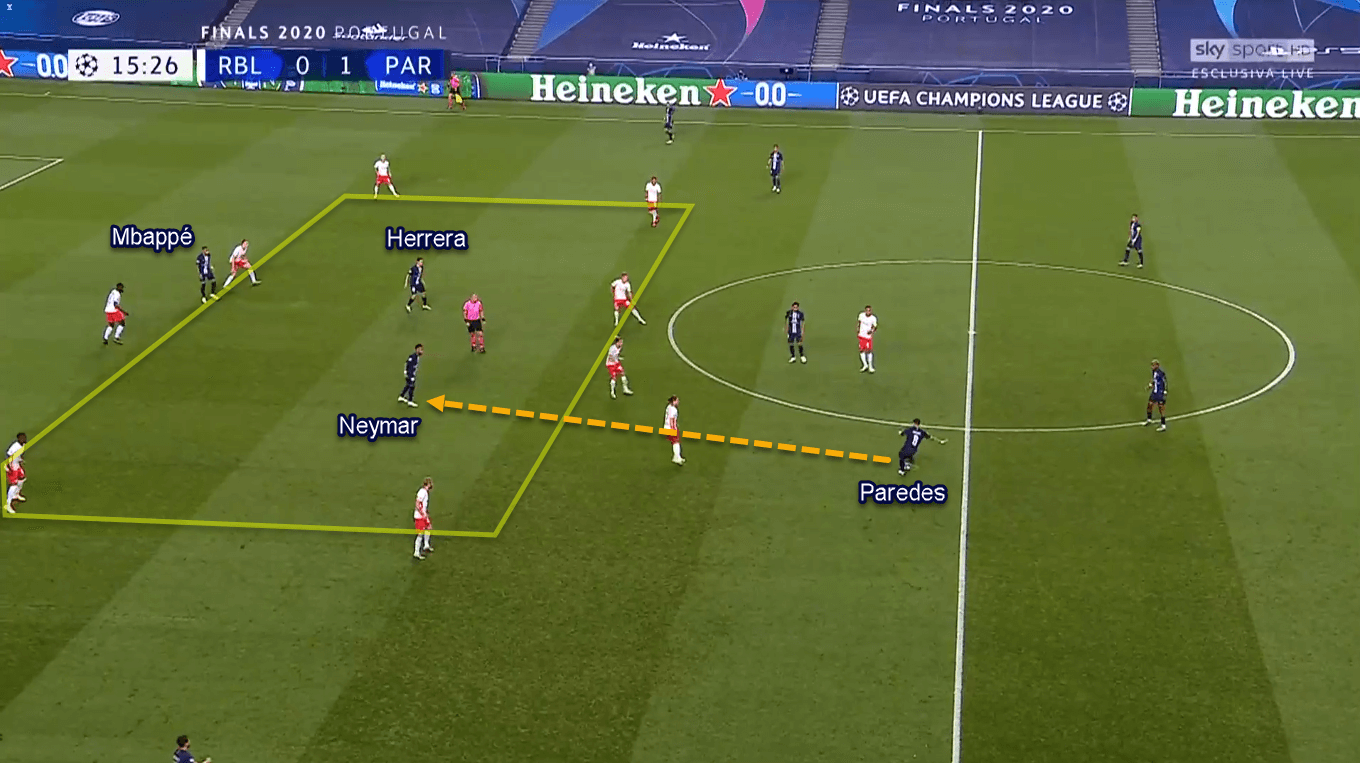
Leipzig’s tight defence (part one)
Despite not pressing aggressively, Leipzig deployed well-planned defensive tactics to combat Paris’ attacks. Primarily, they would sit in a mid-block 4–1–4–1. There were two notable features of their off-possession structure: the vertical compactness, and the rather high defensive line. The combination of both features was used to prevent PSG from accessing the area in between the lines.
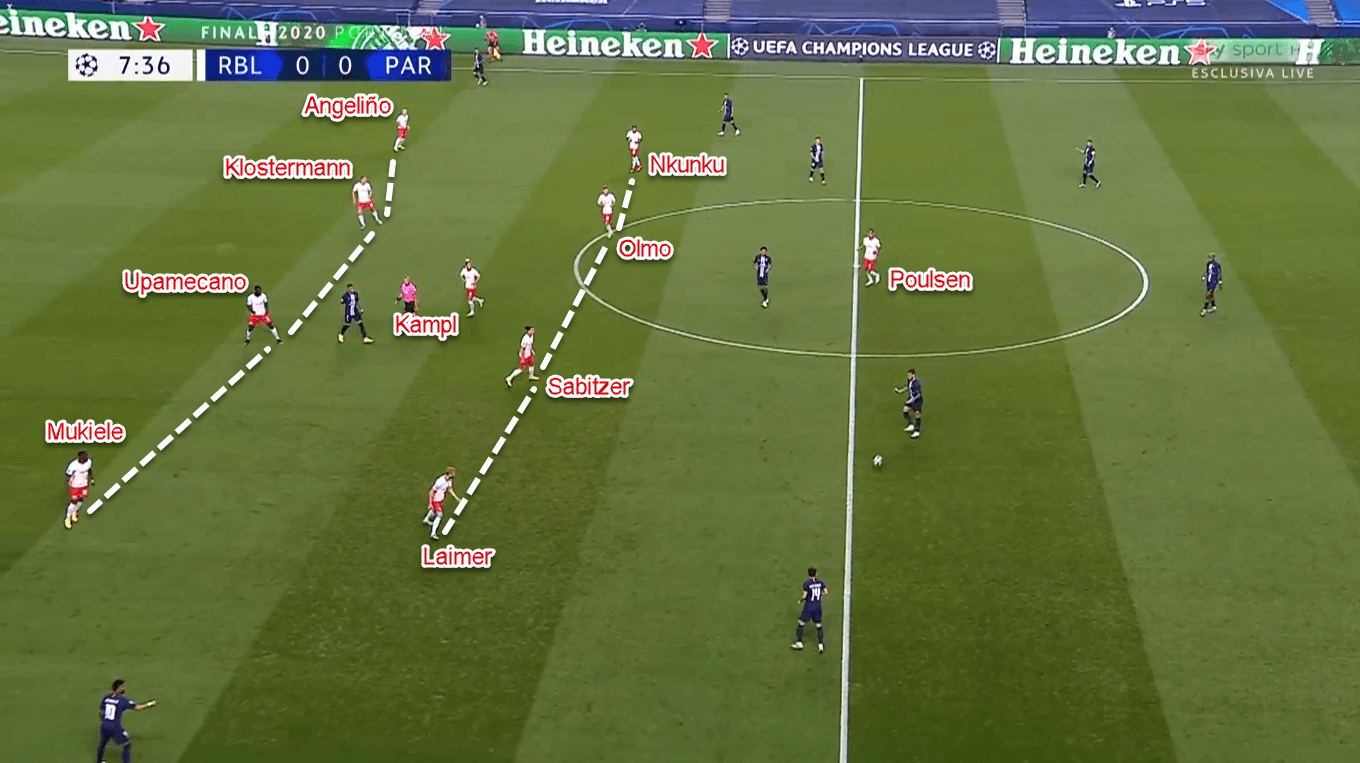
Leipzig’s first focus in their press was to shut Paredes down, due to the Argentine’s passing ability. In the process, Nagelsmann asked Marcel Sabitzer to step up from his initial position and press Paredes. To be more specific, Sabitzer would go alongside Poulsen to execute the press. His space then could be left temporarily empty or filled by the advancing defensive midfielder Kevin Kampl. This was the reason why we could see Leipzig in a 4–4–2-ish manner on some occasions.
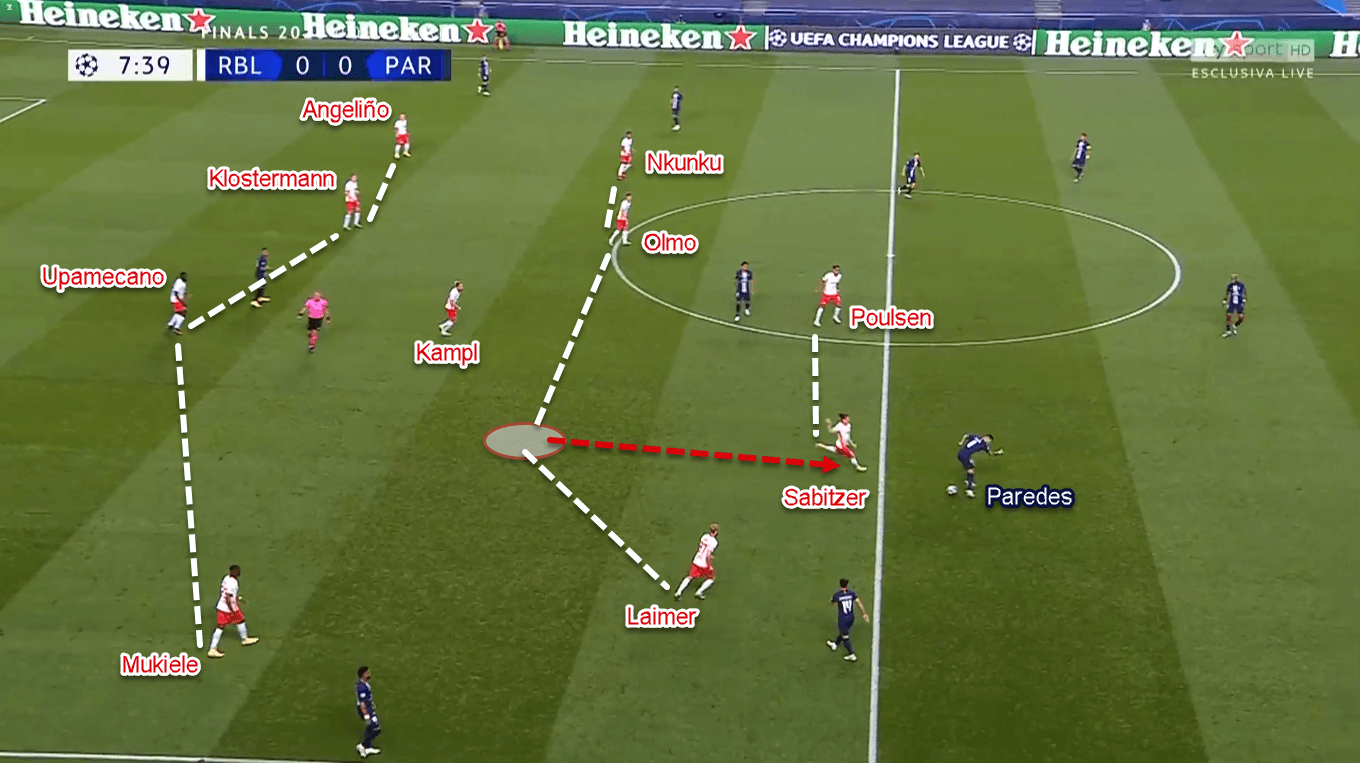
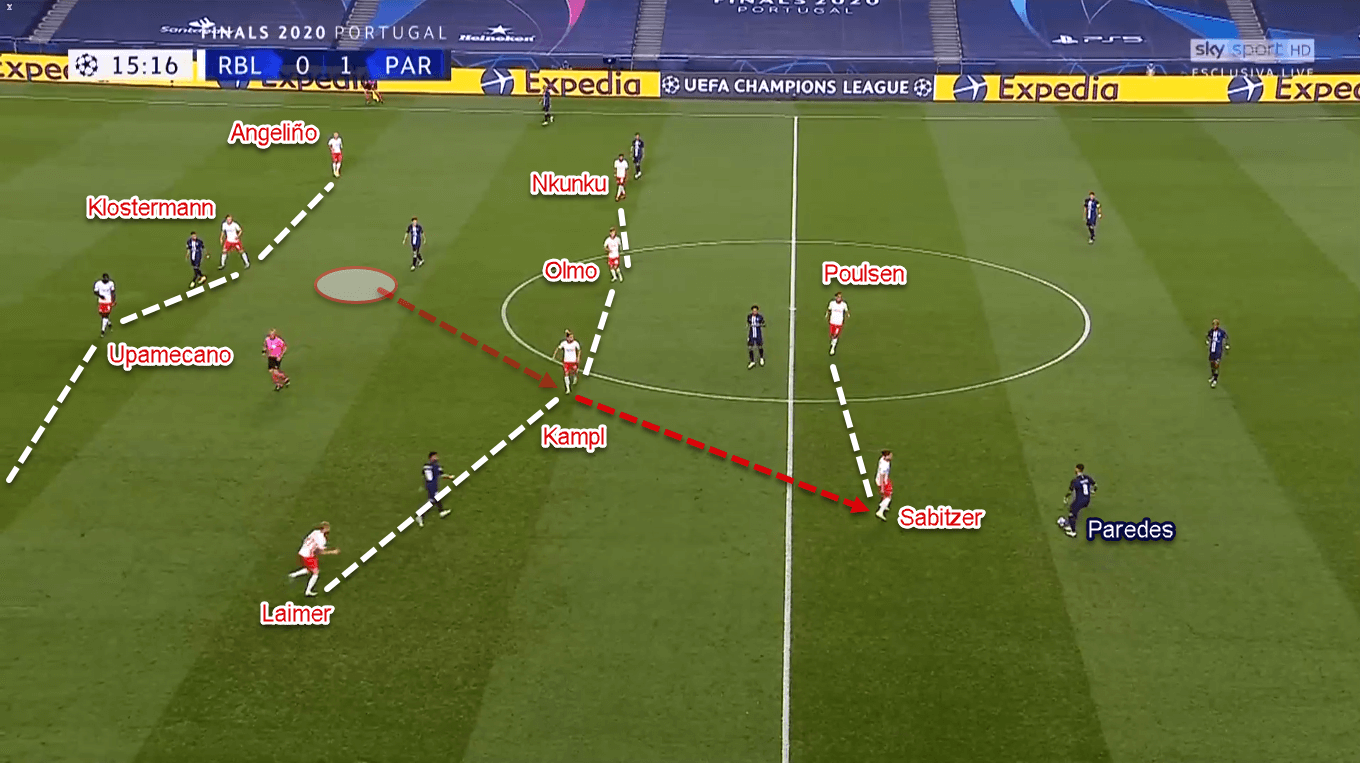
Leipzig’s tight defence (part two)
However, this practice was not perfectly put into practice at all times. Sometimes Paredes did have enough space and time with the ball to produce vertical/diagonal passes to Neymar. This was good for Leipzig, as they had a particular tactic to combat this.
If the ball reached Neymar (or any Paris player in between the lines), Leipzig would surround the on-ball opponent with two to four players. Those include the marauding ball-side centre-back, Kampl, and at least one of the central midfielders: either Dani Olmo or Sabitzer would happily drop and back-press the man in blue. By doing that, Leipzig prevented Neymar from having much time and space to create chaos, and sometimes even gave themselves the chance to win the ball back.
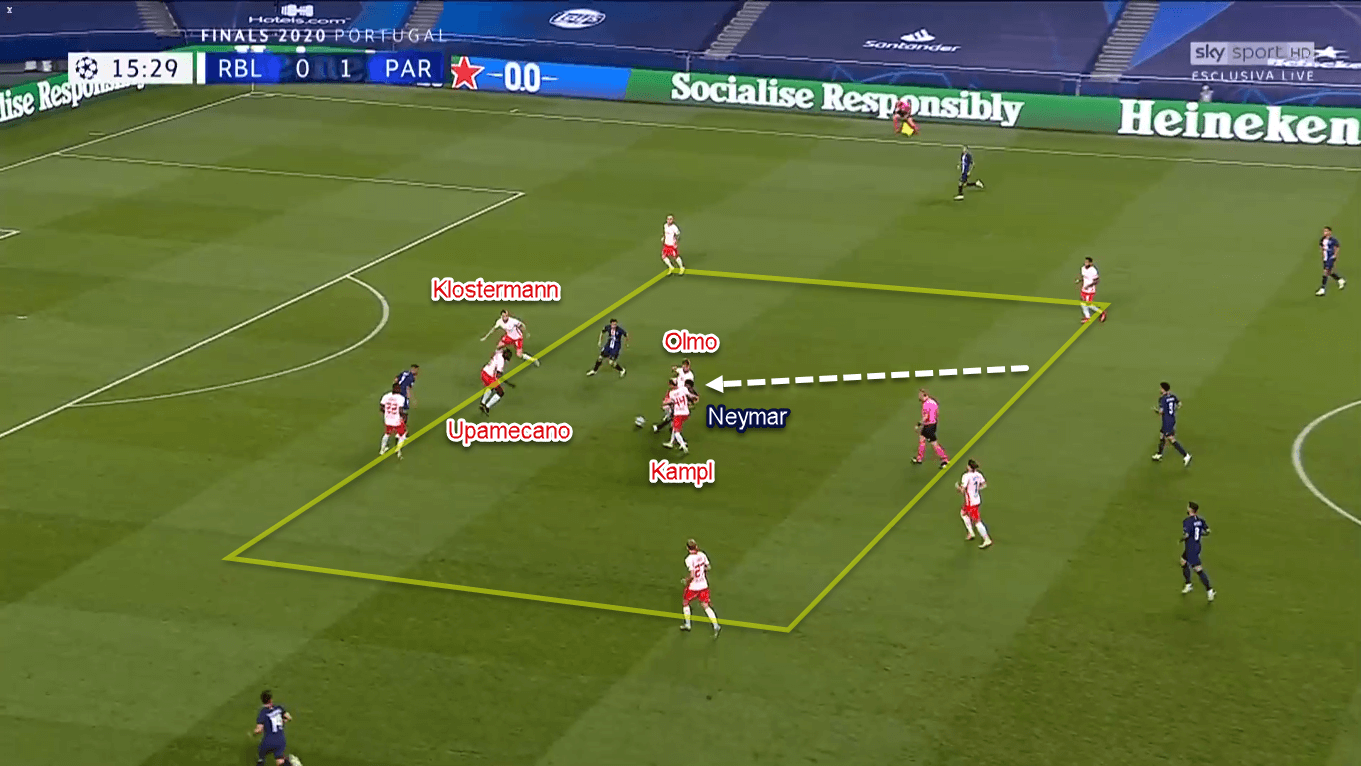
Knowing that Die Roten Bullen defended very compactly, Paris tried another way. That was by utilising Silva’s passing ability to find Mbappé in behind. This particular strategy was also chosen to exploit Leipzig’s rather high defensive line. However, this approach didn’t bear much fruit because of Upamecano’s brilliance to cut Silva’s lofted passes. The statistics showed Upamecano finished the game with three (75%) interceptions and five (71.43%) defensive duels won – the best rates among his teammates.
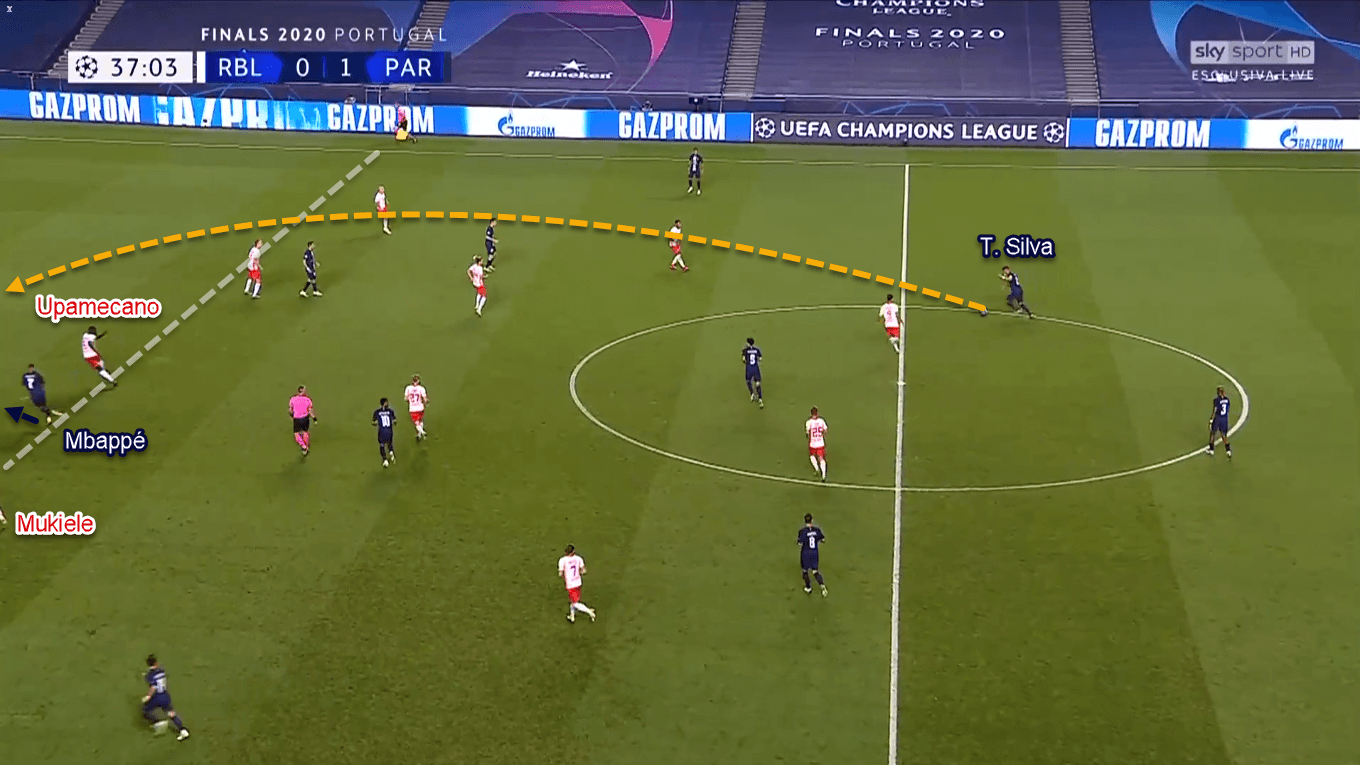
Leipzig try to play short, …
Now we move to Leipzig’s offensive tactics. First of all, let’s take a look at their short goal-kick structure. Leipzig used an interesting rotation between their players to ensure Gulácsi had various short passing options to play for.
The first player used out of his position was Upamecano. Instead of staying in parallel with Gulácsi in the right half-space, Nagelsmann tasked the centre-back to step up. To be more specific, he would stand next to Kampl and give more vertical options for the goalkeeper.
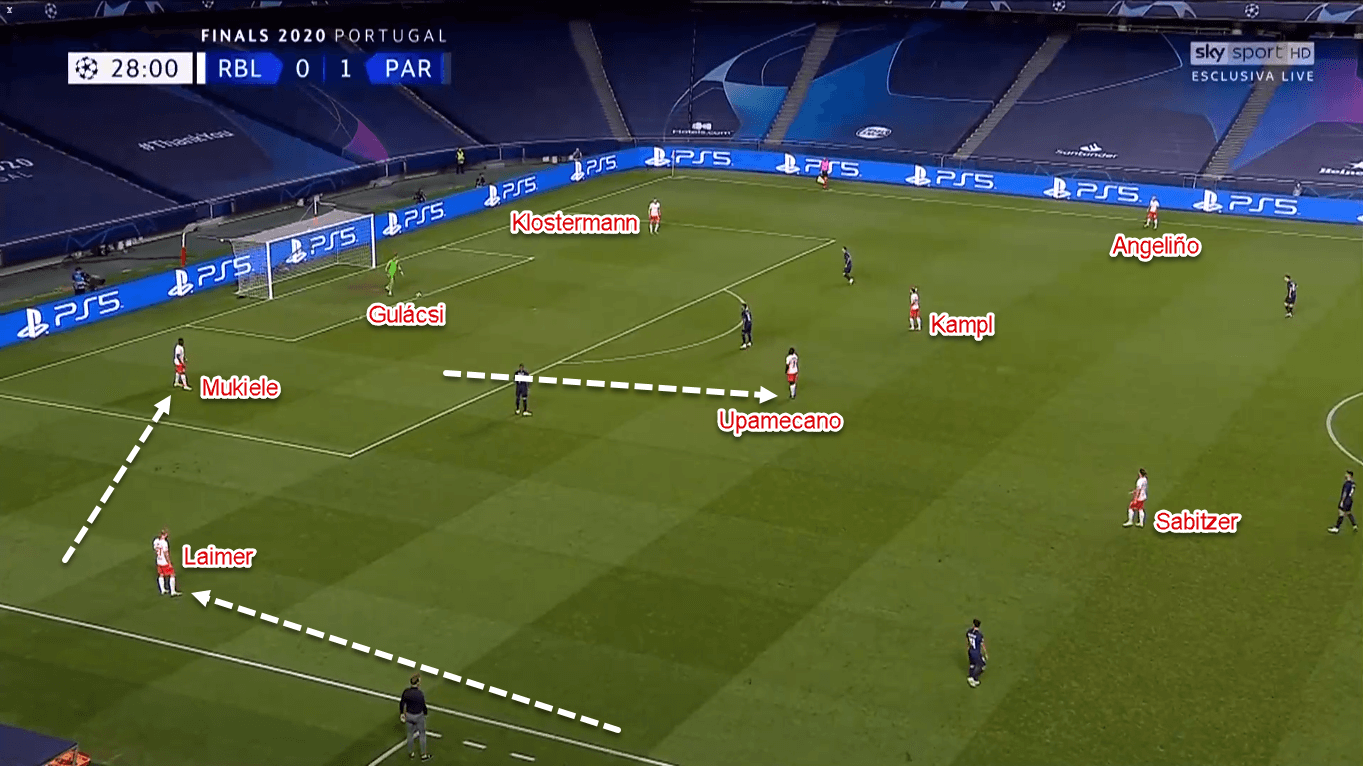
Upamecano’s position then was filled by Nordi Mukiele. The right-back dropped from his designated area and tucked himself next to Gulácsi. The objective was to offer himself as a short right-side option for the goalkeeper. Then, Mukiele’s position was filled by the dropping Laimer. By doing so Laimer would play in parallel with Upamecano, Kampl, and Angeliño in Leipzig’s second attacking line.
Unfortunately, their short build-ups were countered brilliantly by PSG. The next part of the analysis will dig deeper into this.
… but PSG have another idea
Paris deployed a high-press to prevent Leipzig from building their plays from the back. Structure-wise, they used 3–1–3–3 or a lopsided 4–1–2–3. In their first line of pressure, the trio of Neymar, Mbappé, and Di María stayed close to each other just in front of Leipzig’s penalty box. The objective behind that was to prevent Gulácsi from accessing Kampl or Upamecano vertically. If the goalkeeper chose to play the ball horizontally, Paris’ wingers would step up and press the centre-back in their respective area, thus forcing Leipzig to play wider.
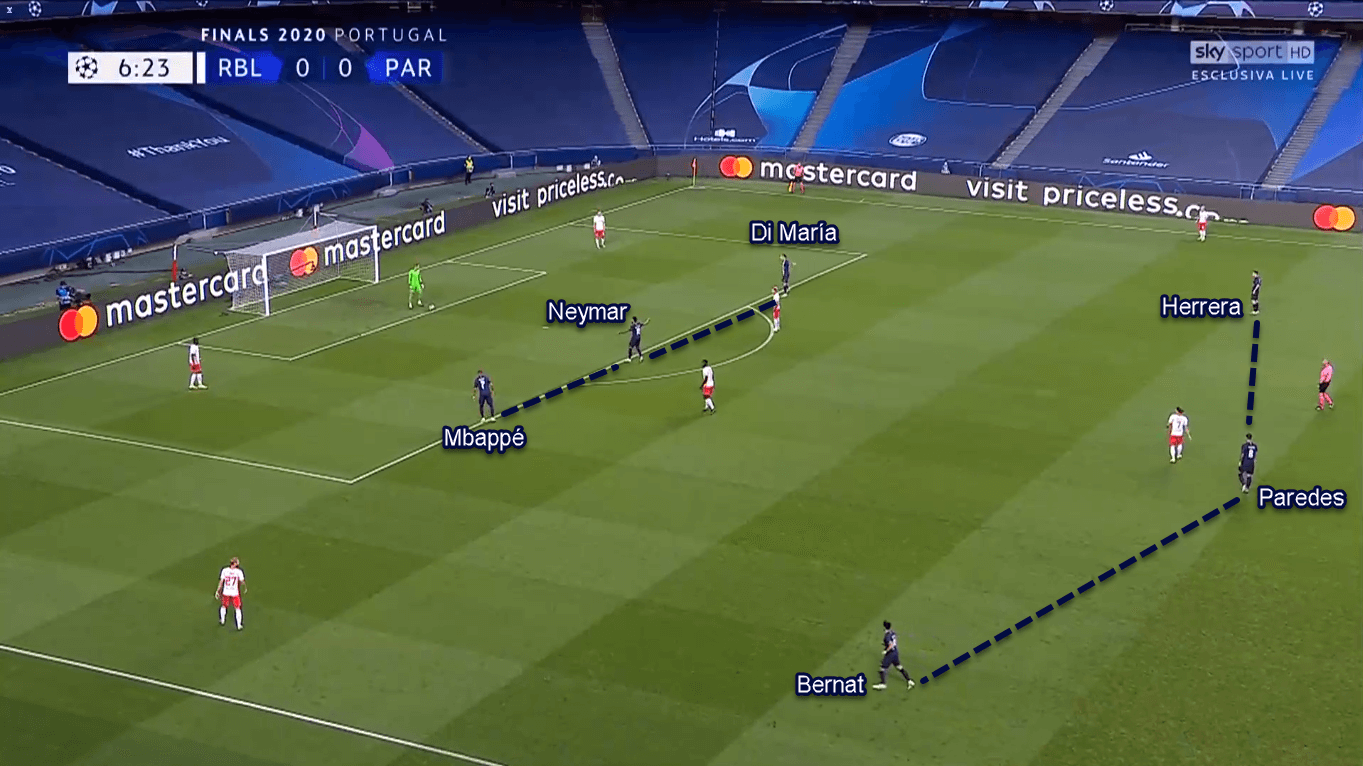
Behind the attacking trio, there were Herrera, Paredes, and the left-back Bernat. If Leipzig tried to play through the wide areas, either Herrera or Bernat would close down the on-ball flank player immediately. It means if Angeliño had the ball, Herrera would press him; if Laimer had the ball, Bernat would do the press.
PSG’s side-press was not just that, though. They would also try to close all nearby passing options for Angeliño and Laimer when they got the ball. It meant that Paris’ ball-side winger, centre-forward, and Paredes would join the press and prevent Leipzig’s full-backs to play shortly. Leipzig couldn’t play the ball long either. That’s because Marquinhos and the remaining defenders stayed centrally in their zone to clear any direct balls targeted to Poulsen and co.
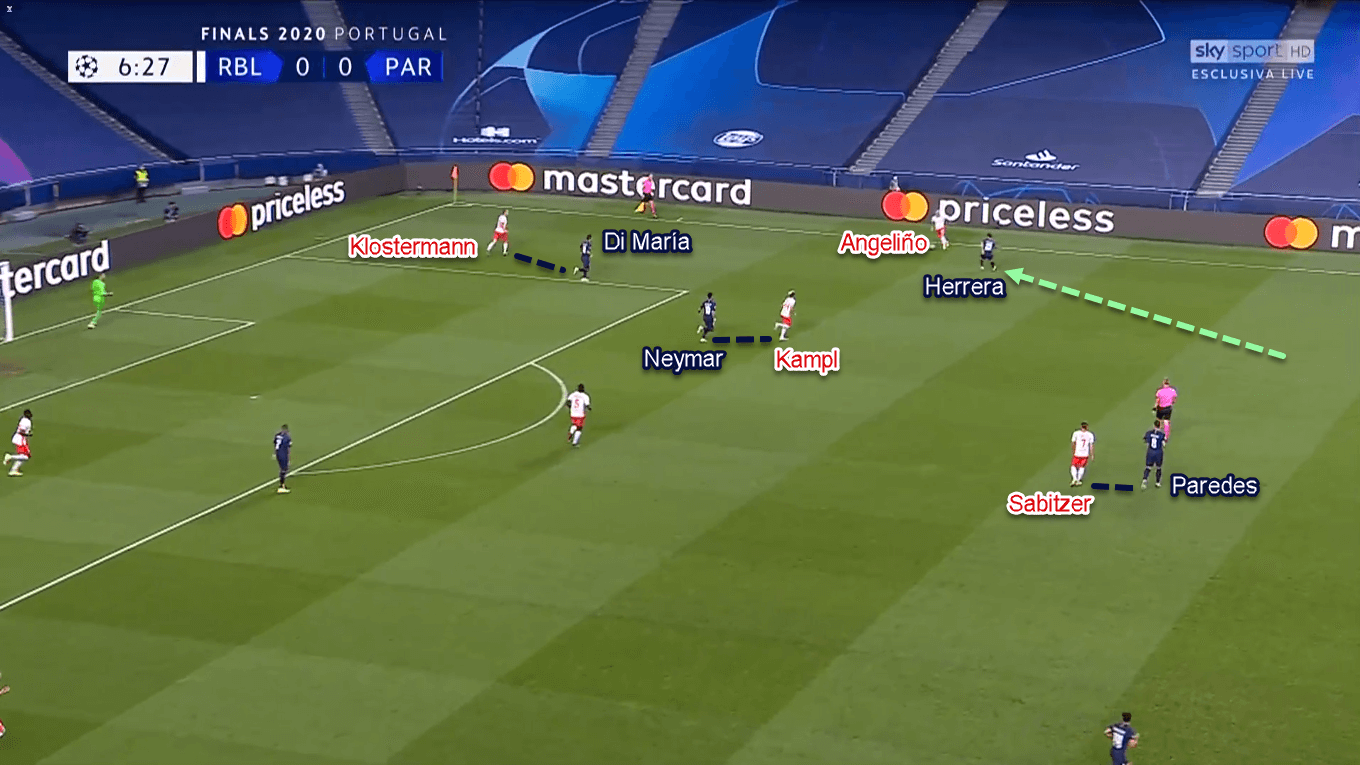
Always press Gulácsi
Another interesting feat in Paris’ press was their attackers’ task to press Gulácsi at all times. This was probably because of the goalkeeper’s lack of composure with the ball. To execute the press, Tuchel asked one of his attackers to close Gulácsi down. By doing so, the pressing attacker would leave his man in his cover shadow and quickly press the goalkeeper.
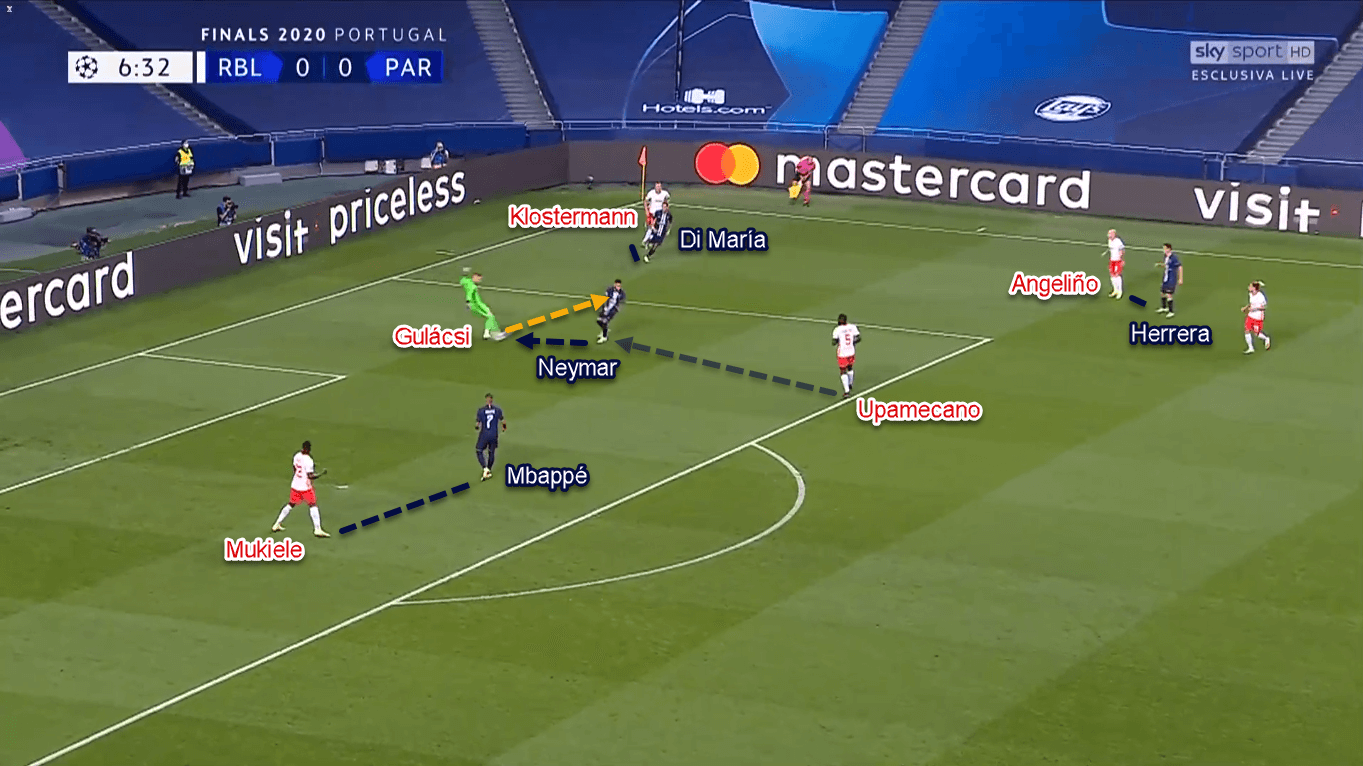
The aggressive press would limit Gulácsi’s time with the ball and forced him to commit more mistakes. If we look at the stats, he only made 10 (71.43%) accurate passes in the first half, underlining PSG’s success to exploit the goalie. For a further fact, Di María’s goal started with this particular strategy.
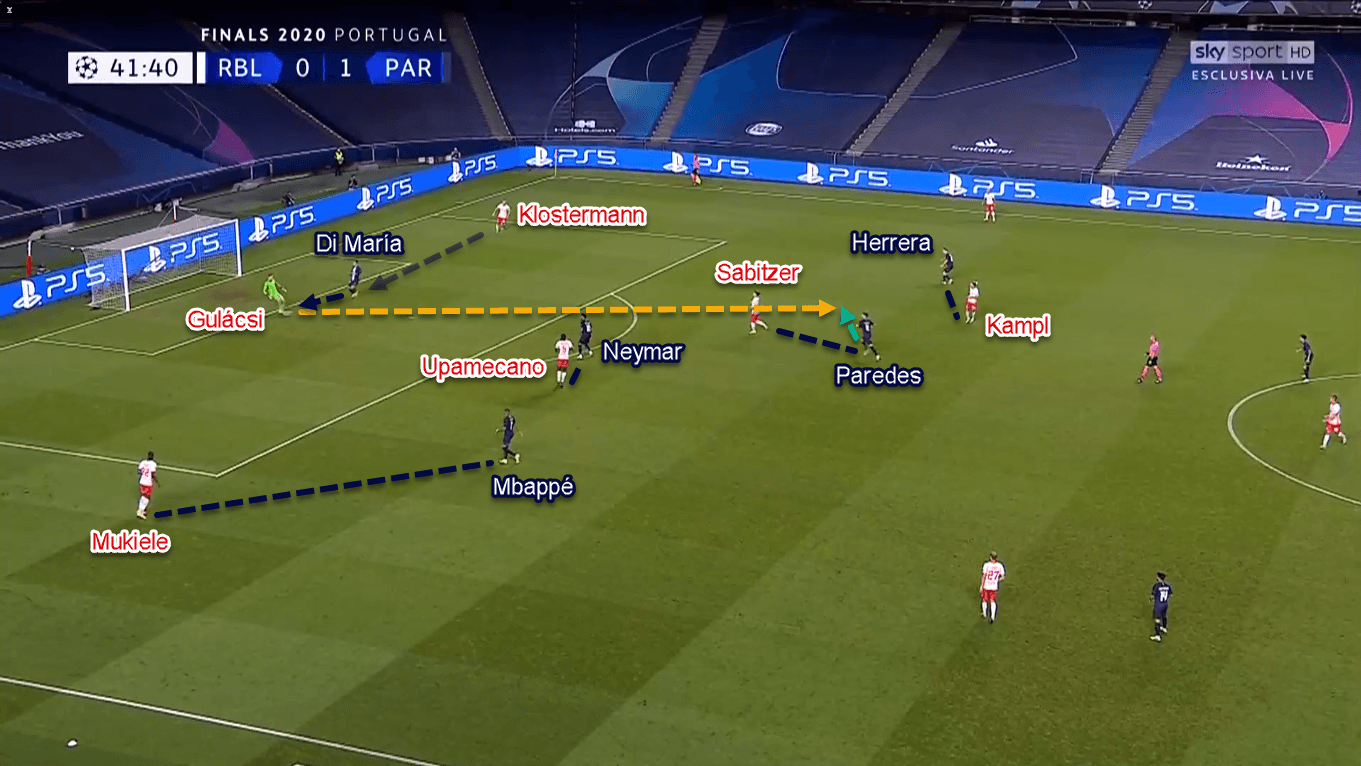
Leipzig’s attacking ideas (part one)
When Leipzig enjoyed the ball, they would shift from their initial 4–1–4–1 to a 3–2–5-ish shape. In that new structure, both full-backs had contrasting tasks. Mukiele was tasked to drop alongside the centre-backs while Angeliño had to step up and provide width in advanced areas.
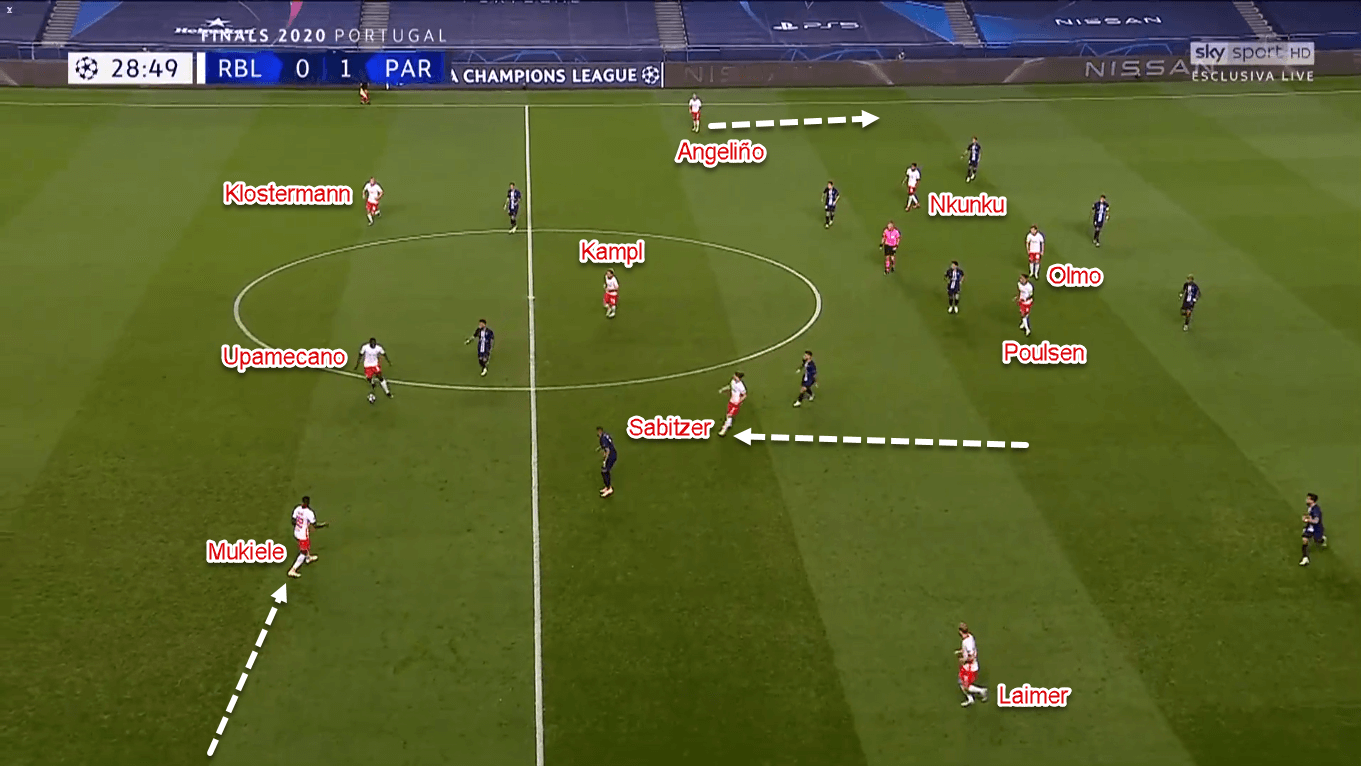
Similarly, contrasting tasks could also be found in the midfield line. One midfielder — Sabitzer — would drop alongside Kampl, while Olmo moved forward, even next to Poulsen at times. The former’s dropping movement would allow Leipzig’s centre-backs to have more vertical options in the middle. Meanwhile, Olmo’s rather free movement would give Leipzig more presence in their attacking line.
When they had the ball, Leipzig would try to find one attacker in between the lines. To be more specific, the distributing role was given to one of the centre-backs – mostly Upamecano. Up front, Olmo or another attacker would try to receive the line-breaking pass in the half-space.

Leipzig’s attacking ideas (part two)
After that, Leipzig would continue the attack by sending the ball wide, either to Laimer or Angeliño. Both of them were tasked to send crosses into the box as soon as they reached PSG’s defensive third. In the box, there would be up to three options for the crosser: those being Poulsen, Nkunku, or Olmo, and one of the midfielders.
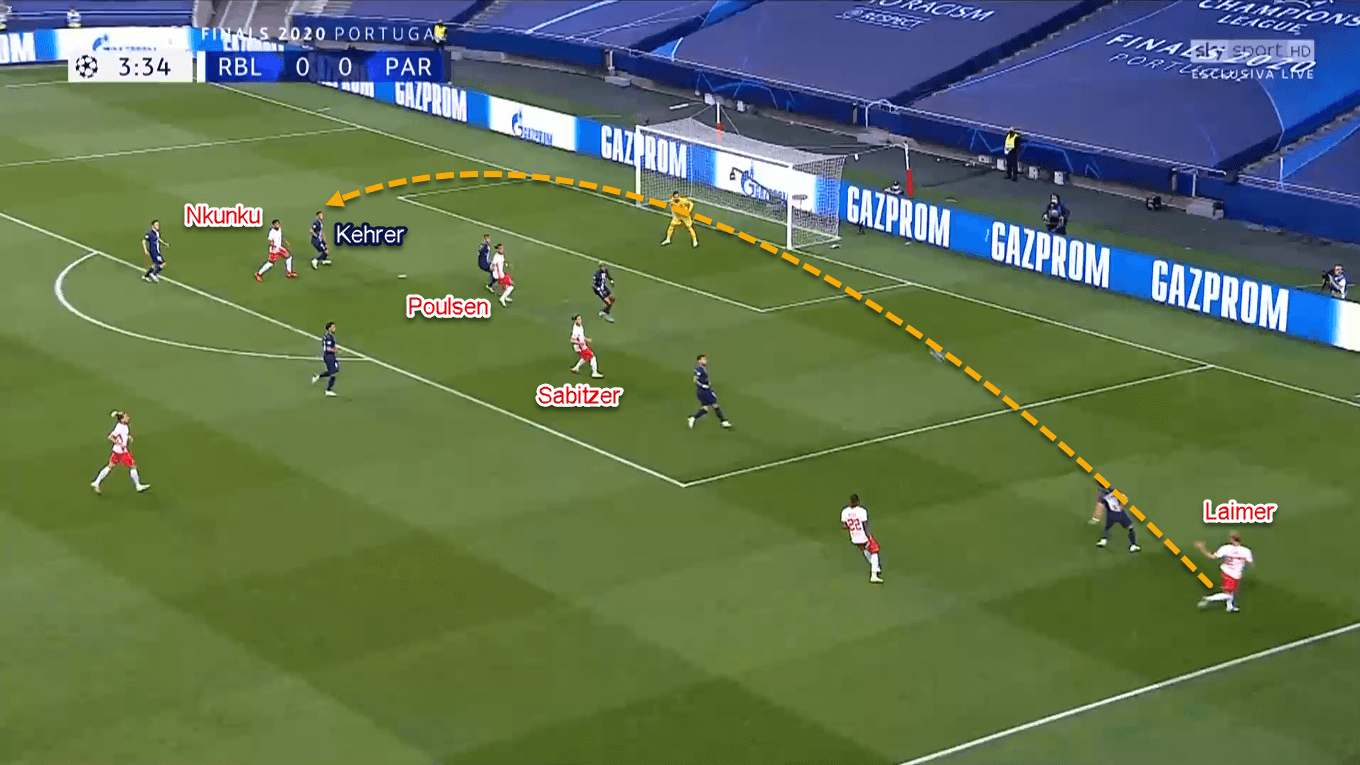
Furthermore, Leipzig tried to attack the far-post area with their crosses. This was because the particular area was ‘only’ defended by PSG’s full-backs, rather than their centre-backs. However, this approach wasn’t very effective. The statistics showed that Leipzig only made seven (33.33%) accurate crosses throughout the game. Angeliño was the least impressive, with only two (28.57%) successful cross-balls in 90 minutes.
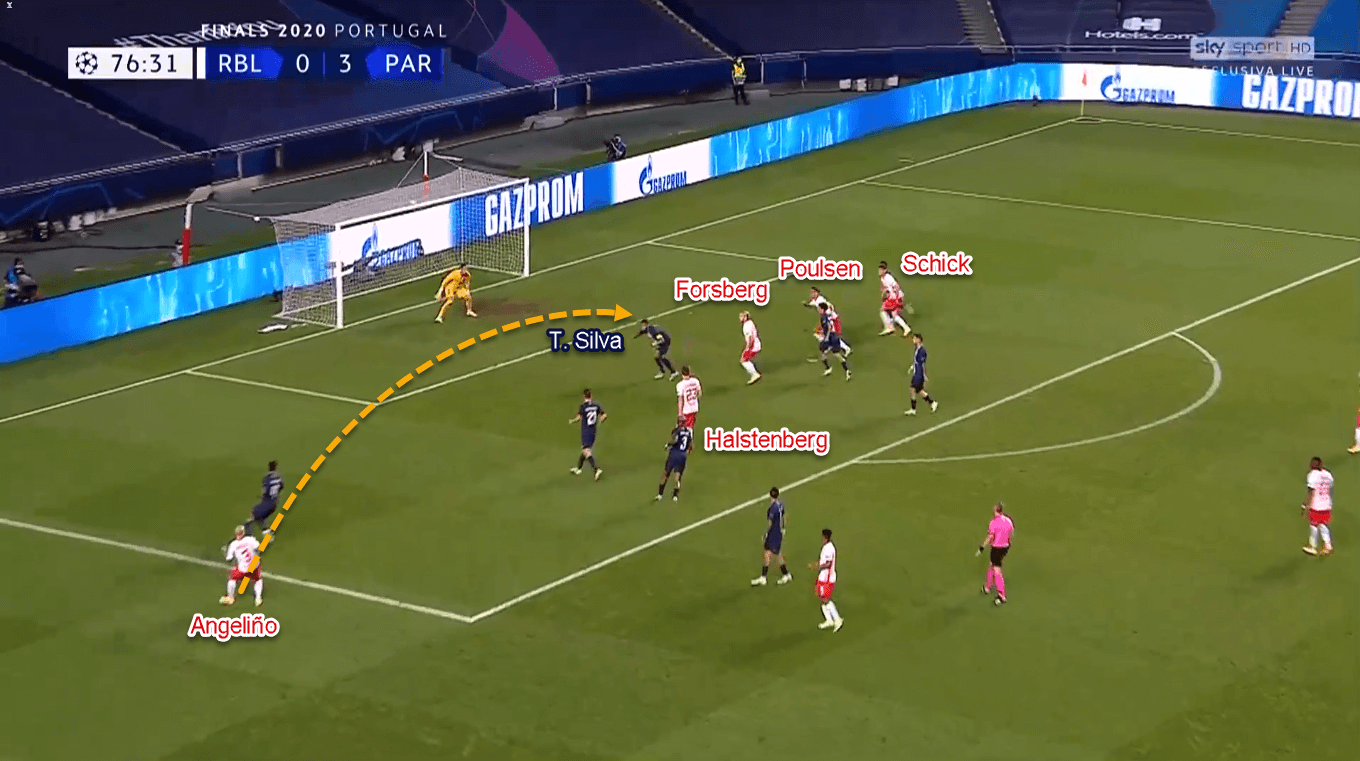
Another reason why the approach didn’t bear much fruit was Paris’ tendency to flood their penalty box when defending. It means that not only were their defenders were tasked to clear Leipzig’s crosses, but the midfield trio could even be found altogether inside the 16-yard-area to nullify Die Roten Bullen’s cross-heavy tactic.
Second-half adjustments from Nagelsmann
RB Leipzig went for a more aggressive approach defensively in the second half. Instead of sitting down in a mid-block 4–1–4–1, they moved into a more gung-ho 5–3–2-ish high-press. The high-press was chosen to prevent PSG from building their plays smoothly from the back and to provoke mistakes in advanced areas.
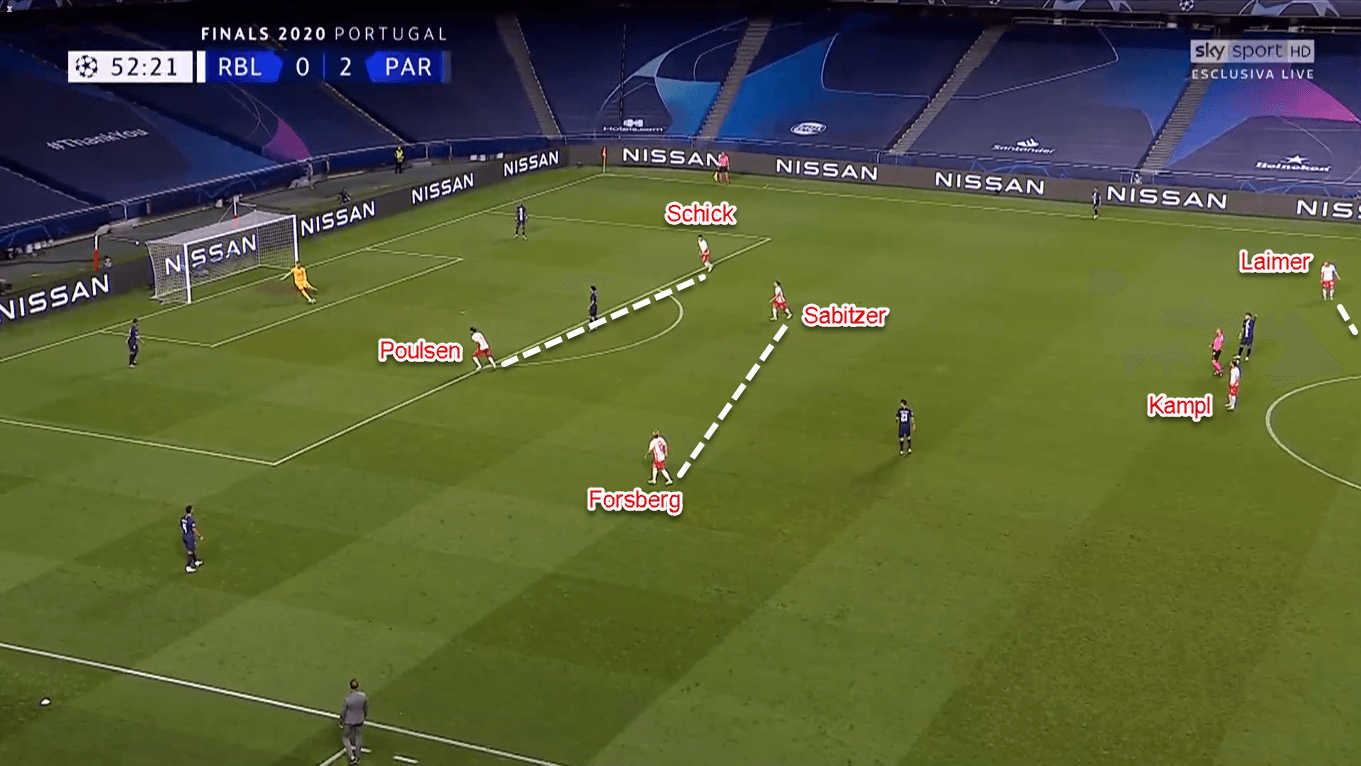
Leipzig’s first line of press consisted of two attackers: Poulsen and Schick. Behind them, two midfielders — Forsberg and Sabitzer — stood more advanced than Kampl. Those two lines of pressure were tasked to close the central lanes and force Les Parisiens to build through the flanks.
When the ball went wide, Leipzig deployed a similar tactic to PSG. That was to close all nearby passing options when either Kehrer or Bernat having the ball. The objective behind that was to force the on-ball PSG player to play ineffective longer balls to their attackers.
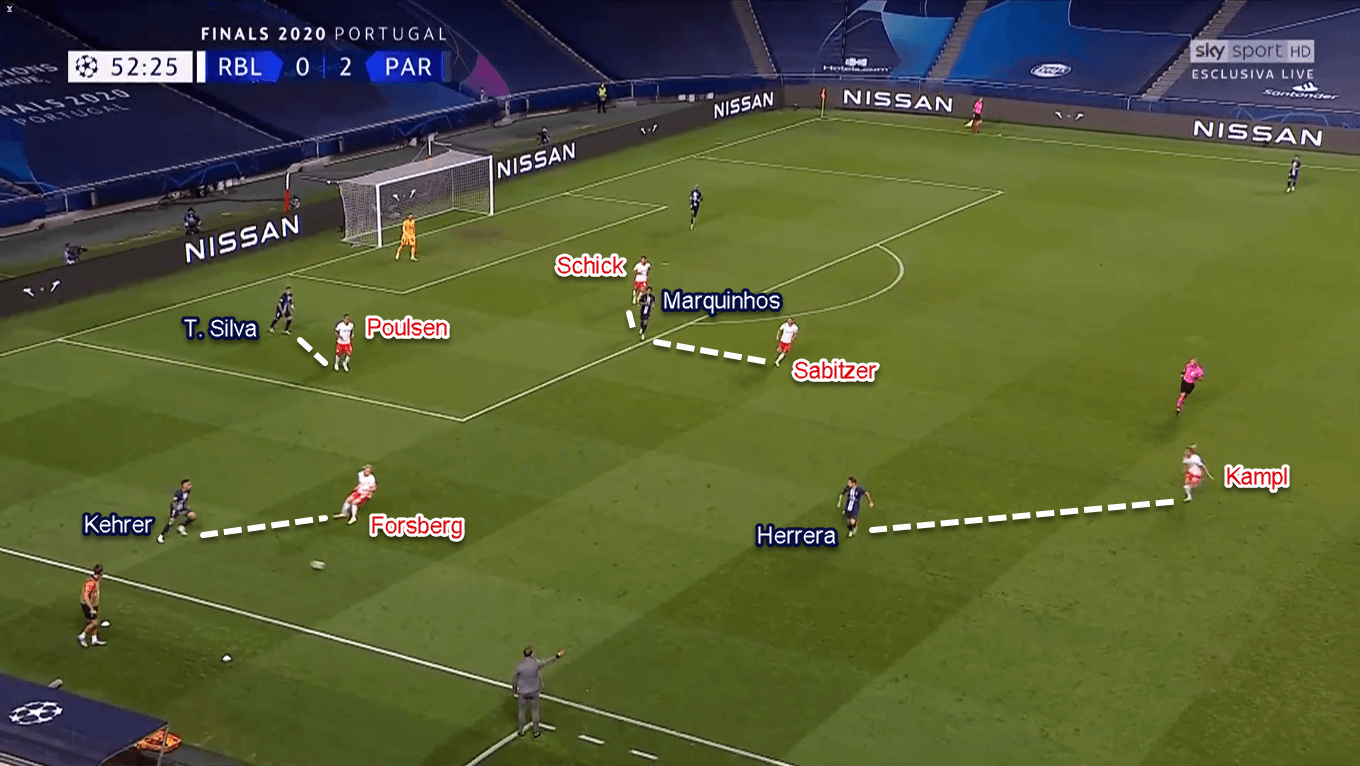
Offensively, Leipzig kept the 3–2–5-ish shape. However, there were not many rotations compared to the first half because Mukiele and Angeliño now served as full-time wing-backs in the three-centre-back system. There were not many tactical changes either. Leipzig kept the cross-heavy tactic despite their lack of an end product. For a fact, they only made five (35.71%) successful crosses from 14 attempts in the second half.
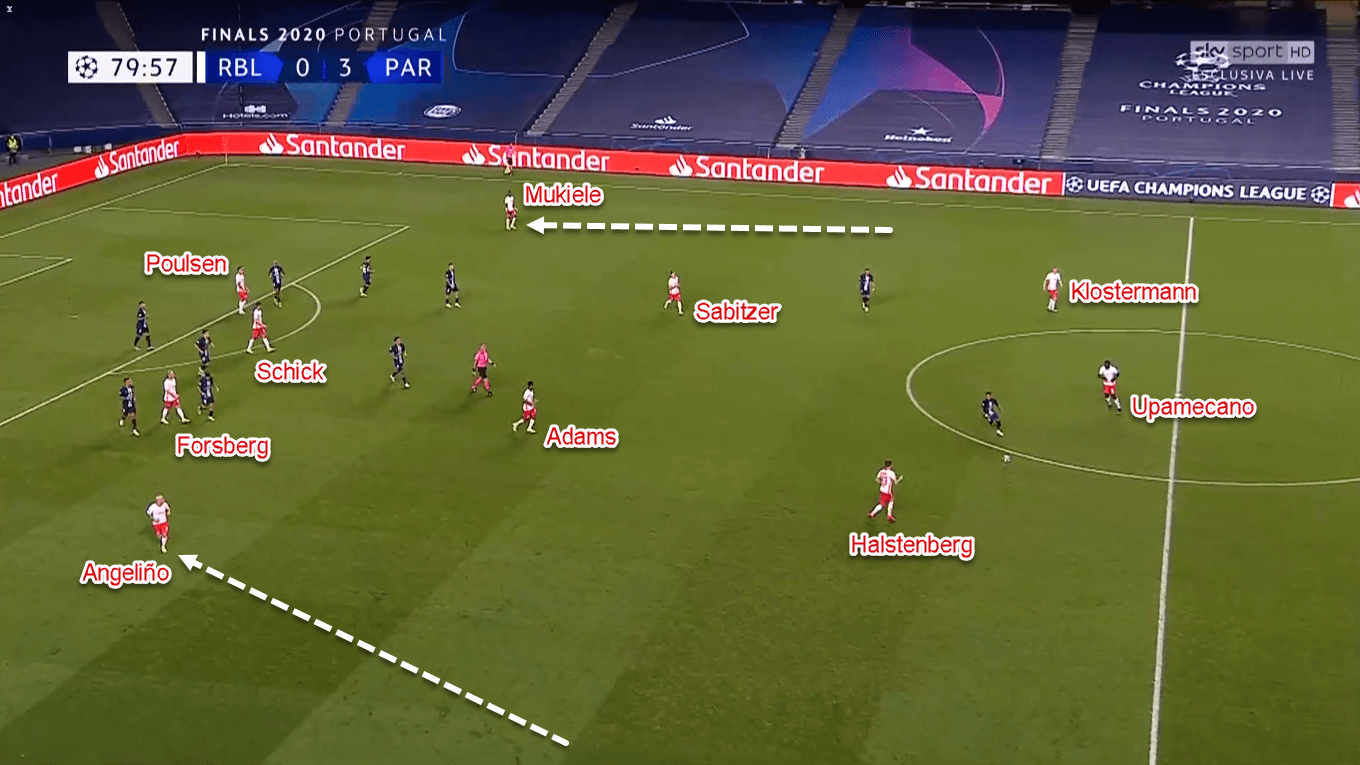
Conclusion
After seven years of wait, modern-era PSG finally made their way to the UEFA Champions League final. Everyone can give credit to Neymar and Di María for their magical performances. But, the biggest praise should go to the 46-year-old Tuchel. The former Borussia Dortmund tactician successfully outsmarted his protégé-turned-rival Nagelsmann in this enthralling semifinal.
Despite the result, appreciation must also go to Nagelsmann. His well-planned defensive tactics worked quite well to nullify Mbappé and co. from scoring via positional attacks. Only 33 at the moment, the young manager still have years — even decades — ahead of him to bring the Ol’ Big Ears to his (future) home.




Comments